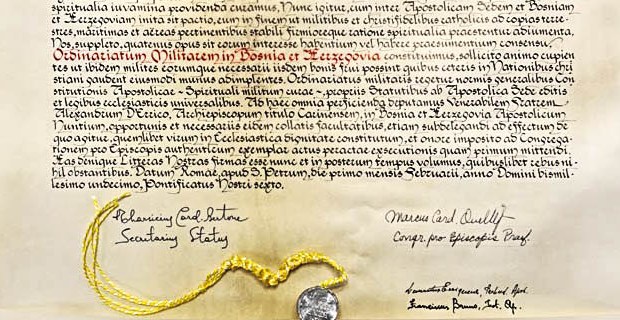The Church is often described as the “Barque of Peter,” with the pope as the captain. It is the pope’s duty to guide the ship through the turbulent waves of the world to reach the eternal shores of Heaven.
One way the pope has guided the Church throughout the centuries is through papal documents. These are intended for the benefit of the Christian faithful and are geared towards specific situations or theological topics.
Here is a brief guide to different papal documents, including examples of each.
Encyclical
Originally this type of document was simply a letter sent around by the bishops. Over time it became an official papal document that focuses on a particular Catholic doctrine. It is usually addressed to the bishops and priests of the Church. Pope Francis’ primary encyclical thus far has been Laudato si’, on the care of creation.
Papal bull
At times popes will issue an official declaration or announcement. These documents traditionally bear a round seal made of lead; portraits of Sts. Peter and Paul appear on one side, and the name of the pope on the other. The Latin word for a round seal or medallion is bulla (literally, “bubble”), so documents with this kind of seal became known as papal bulls. St. John Paul II issued a papal bull to announce the Jubilee Year of 2000.
Apostolic constitution
This type of document includes solemn “magisterial” actions of the pope — for example, the erection of a new diocese or changing the norms governing church schools and universities. Pope Francis has issued several, including one entitled Veritatis Gaudium, on “ecclesiastical universities and faculties.”
Motu proprio
A motu proprio (Latin for “by his own hand”) is a letter issued by the pope himself, and can be on any topic or governance issue. Pope Benedict XVI issued a motu proprio for the approval and publication of the Compendium of the Catechism of the Catholic Church.
Apostolic letter
These letters are usually are designed to clarify doctrinal matters in the Church, but can also be used for other important topics. St. John Paul II wrote an apostolic letter to those responsible for communications.
Apostolic exhortation
Similar to apostolic letters, an exhortation is usually that, an “exhortation” that urges the Church to consider a particular spiritual matter important to the pontiff. They are frequently written after a special synod. Pope Benedict XVI wrote an apostolic exhortation, Verbum Domini, in which he encouraged, among other things, the practice of lectio divina (prayerful reading of scripture).

Read more:
How to tell the difference between a monsignor, a bishop and a cardinal

